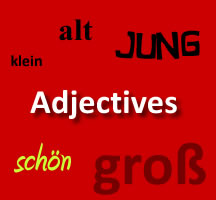Adjective Endings

When creating a sentence that uses an adjective to describe something, one must put an ending on the adjective to give the gender of the noun being described. When the adjective follows an ein word (ein, eine, einen, meine), you would use the first chart. If the adjective follows a der word (der, die, das), you would use the second chart.
| Noun | Subject | Direct Object | Indirect Object |
|---|---|---|---|
| ein | |||
| eine | |||
| ein | |||
| meine (plural) |
Example:
Garfield is a lazy cat.
Garfield ist eine faule Katze.
Cat(Katze) is feminine, so the correct article would be "die". Since the adjective follows the word eine, "e" would be added on the end of faul(lazy).
| Noun | Subject | Direct Object | Indirect Object |
|---|---|---|---|
| der | |||
| die | |||
| das | |||
| die (plural) |
Example:
The dog is playing with the red ball.
Der Hund spielt mit dem roten Ball.
Ball(Ball) is masculine, so the correct article would be "der". Since the word "the"(der) follows the word "with"(mit), the ball(der Ball) is now an indirect object. Using the table, it is seen that now the word "red"(rot) must have "en" placed on the end.